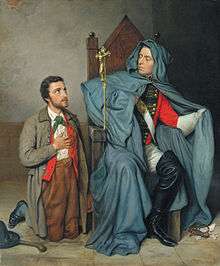Charlotte Schreiber

Charlotte Mount Brock Schreiber (1834–1922) was an English-Canadian painter and illustrator, considered among the first and finest of Canada's female painters.[1]
Schreiber, née Morrell, was born in Essex, England. She initially studied at an art school in London with a teacher who had a background in surgery, which informed her careful observation of, and interest in, the human form: she wrote in 1895, "The human hand, the finger nail, the foot, every portion of the living body, the parts of a flower, are divinely beautiful … it is a joy to paint them as they are in reality".[1] She later studied under John Rogers Herbert, a member of the British Royal Academy of Art. Schreiber exhibited at the Royal Academy at the age of only 21. In 1875 she married and emigrated to Canada with her husband, settling in the area of Toronto. She was soon appointed a board member of the Ontario School of Art, and was a member of the Ontario Society of Artists (1876–1889).
Schreiber was the first female elected to the Royal Canadian Academy of Arts.[2] The National Gallery of Canada holds the painting that she submitted toward her Academy diploma. Titled The Croppy Boy (The Confession of an Irish Patriot), it is based on the Irish ballad "The Croppy Boy", which was popular during the Irish rebellion of the 1790s. It tells the story of a youth who stops in a church to confess his sins as he prepares for the battle of Wexford. His audience, however, is not a Catholic priest, but a disguised British soldier who arrests him and takes him for execution. The painting shows the youth on his knees, earnestly addressing the cloaked soldier, whose uniform is visible to the viewer but not to the penitent. The two figures are united by the red in their clothing, but the soldier occupies the shadowy portion of the canvas, with the youth on the lighter side, perhaps suggesting Schreiber's sympathies.[3]
Her art was influenced by literature, including her early illustrations of poems by Chaucer (The Legende of the Knight of the Red Crosse), Edmund Spenser (The Faerie Queene, illustrated 1871), and Elizabeth Barrett Browning (The Rhyme of the Duchess May, 1874).
Schreiber moved back to England in 1898 after the death of her husband, and she died in Paignton, South Devon, England in 1922.
References
- 1 2 Charlotte M.B. Schreiber Archived March 14, 2009, at the Wayback Machine.. Libraries and Archives Canada. Accessed June 16, 2010
- ↑ Records of the Founding of the Royal Canadian Academy of the Arts. Toronto: Globe Printing Co. 1879–80. p. 16.
- ↑ Newlands, Anne. Canadian Paintings, Prints, and Drawings. Firefly Books, 2007. Page 288. ISBN 1-55407-290-5
External links
- Schreiber gallery at the National Gallery of Canada
- Canadian Women Artists History Initiative includes an extensive bibliography